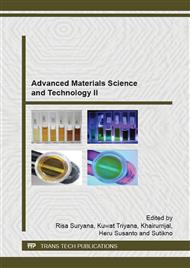[1]
Y. Sigit, Sabirin, B. Kusarpoko, B. Triwiyono, A. Marjono. Application Technology of Modified Sorghum Flour Production for Wheat Flour Substitutes for Processed Food Industry Raw Materials with Capacity 1 Ton/Day. Deputy of Agro-Industry Technology and Biotechnology. Assessment and Technology Application Institute. (2013).
Google Scholar
[2]
Y. Pranoto, S. Anggrahini, Z. Efendi. Effect of Natural and Lactobacillus plantarum Fermentation on In-vitro Protein and Starch Digestibilities of Sorghum Flour. Food Bioscience 2 (2013) 46-52.
DOI: 10.1016/j.fbio.2013.04.001
Google Scholar
[3]
M.P. Sirappa, Development Prospects Sorghum in Indonesia as Commodities Alternatives for Food, Feed, and Industry. Jurnal Litbang Pertanian 22 (4) (2003) 133-140 (in Indonesia).
Google Scholar
[4]
Apriwinda. Study on Fermentation of Sweet Sorghum Juice (Sorghum bicolor (L) Moench) for Ethanol Production. Bachelor Thesis at Department of Agricultural Technology Faculty of Agriculture, Hasanuddin University. (2013) (in Indonesia).
Google Scholar
[5]
ICRISAT (International Crops Research Institute for the Semi-Arid Tropics). Industrial Utilization of Sorghum: Summary Proceedings of A Symposium on the Current Status and Potential of Industrial Uses of Sorghum in Nigeria, 4-6 Dec 1989, Kano, Nigeria. Patancheru, A.P. 502 324, India.
DOI: 10.21475/ajcs.17.11.04.pne330
Google Scholar
[6]
S. Budijanto, Yuliyanti. Study of Preparation Sorghum Flour and Application for Analogues Rice Production. Jurnal Teknologi Pertanian 13 (3) (2012) 177-186 (in Indonesia).
Google Scholar
[7]
J.R.N. Taylor, T.J. Schober, S.R. Bean. Novel Food and non-Food Uses for Sorghum and Millets. J. Cereal Science 44 (2006) 252-271.
DOI: 10.1016/j.jcs.2006.06.009
Google Scholar
[8]
Suarni. Utilization of Sorghum Flour for Processes Product. Jurnal Litbang Pertanian, 23 (2004) 288-295. (in Indonesia).
Google Scholar
[9]
A. Angelina, T. Rosiana, N. Istianah, S. Gunawan, A.K. Anal. Parameter Examination of Sorghum Grain and Total Analysis Effects of Lactic Acid and pH on Sorghum Flour Baker's Yeast by Fermentation (Saccharomyces cereviceae). Jurnal Teknik POMITS 2 (2) (2013).
Google Scholar
[10]
W. Jiranuntakul, C. Puttanlek, V. Rungsardthong, S. Punchaarnon, D. Uttapap. Microstructural and Physicochemical Properties of Heat-Moisture Treated Waxy and Normal Starches. Journal of Food Engineering, 104 (2011) 246–258.
DOI: 10.1016/j.jfoodeng.2010.12.016
Google Scholar
[11]
C.J. Lee, Y. Kim, S.J. Choi, T.W. Moon. Slowly Digestible Starch from Heat Moisture Treated Waxy Potato Starch: Preparation, Structural Characteristics, and Glucose Response in Mice. Food Chemistry, 133 (2012) 1222–1229.
DOI: 10.1016/j.foodchem.2011.09.098
Google Scholar
[12]
H. Singh, Y.H. Chang, J.H. Lin, N. Singh, N. Singh. Influence of Heat Moisture Treatment and Annealing on Functional Properties of Sorghum Starch. Food Research International 44 (2011) 2949–2954.
DOI: 10.1016/j.foodres.2011.07.005
Google Scholar
[13]
Q. Sun, T. Wang, X. Liu, Y. Zhao. The Effect of Heat Moisture Treatment on Physicochemical Properties of Early Indica Rice. Food Chemistry 141 (2013) 853–857.
DOI: 10.1016/j.foodchem.2013.03.077
Google Scholar
[14]
B.S. Yadav, P. Guleria, R.B. Yadav. Hydrothermal Modification of Indian Water Chestnut Starch: Influence of Heat-Moisture Treatment and Annealing on the Physicochemical, Gelatinization and Pasting Characteristics. LWT-Food Science and Technology 53 (2013).
DOI: 10.1016/j.lwt.2013.02.007
Google Scholar
[15]
H.W. Leach, L.D.M. Cowen, T.J. Schoch. Structure of The Starch Granules, in Swelling and Solubility Patterns of Various Starches. Cereal Chemistry 36 (1965) 534-544.
Google Scholar
[16]
K. Kainuma, T. Odat, S. Cuzuki. Study of Starch Phosphates Monoesters. Journal of Technolology Society Starch 14 (1967) 24-28.
Google Scholar
[17]
R.F. Tester, W.R. Morrison. Swelling and Gelatinization of Cereal Starches, Effect of Amylopectin, Amylose and Lipids. Cereal Chemistry 67 (1990) 551-557.
Google Scholar
[18]
J.M. Harper. Extrusion of Food. CRC Press Inc., Bota Raton, Florida. (1981).
Google Scholar
[19]
L. Wang, P.A. Seib. Australian Salt Noodle Flours and Their Starches Compared to US Wheat Flours and Their Starches. Cereal Chemistry 73 (1996) 167-175.
Google Scholar
[20]
A.G. Gaonkar. Ingredient Interactions Effects on Food Quality. Marcel Dekker. New York. (1995).
Google Scholar


